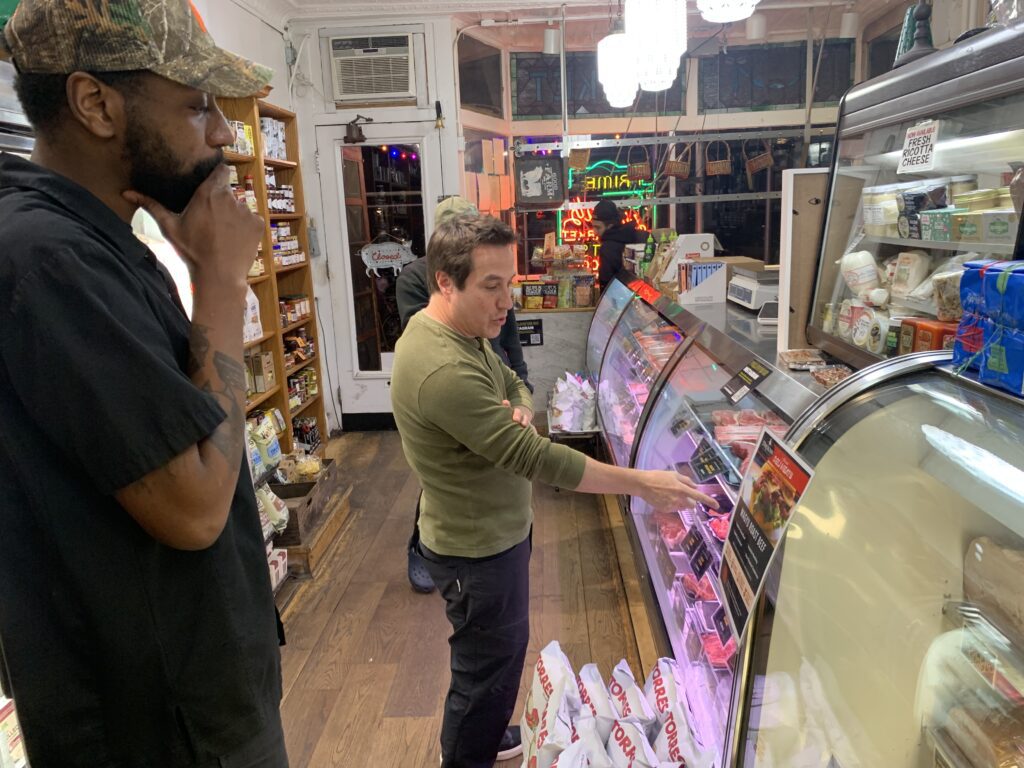Staubitz Market (Photo by Garret Owen)
With community support and a savvy pivot, Staubitz abides
New York's oldest butcher shop was on the brink of collapse a few months ago. Here's how it survived
John McFadden Jr. hasn’t had a chance to eat all day; it’s been too busy. And now, a reporter is here to interview him.
He comes around to the end of the meat counter and leans against a massive carving block. Behind him hangs a sign: GAME BIRDS AVAILABLE: Guinea Hen; Quail; Wild Turkey; Goose; Squab; Partridge. Not mentioned are the dozens of meats, cheeses, sausages, patties, pasta, sauces, jams, oils, peppers and more that fill every square inch of the market space.
McFadden is at the helm of Staubitz Market, the 106-year-old Cobble Hill institution, and New York’s oldest operating butcher shop. “It’s feast or famine here,” he says. “You gotta take it when it comes.” Now, it’s feast time. But last summer, Staubitz barely survived economic starvation.
These days Staubitz is sustained in large part by the loyal consistent few. In his 44 years behind the counter, McFadden has seen customers come in single, get married, have kids and end up grandparents, with their grandkids coming in to buy from Staubitz.

McFadden on the other side of the counter (Photo by Garrett Owen)
“It’s a wonderful, old-fashioned butcher,” says Liz Forman, a regular for more than 20 years. “It’s what I remember from my childhood, what this neighborhood was all about!” Another member of the two-decade club, George Gilpin, comes down from from Prospect Park South for the Staubitz filet. “It’s over 30 minutes, but this is my butcher.”
For its first 80-odd years, Staubitz cemented itself in the city as a premier, high-quality butcher shop. It even managed to turn a steady profit. In the early aughts, though, things began to change: People started to eat less meat. Townhomes that had traditionally housed multiple families in the area were sold to dual income families. “They both work, so they don’t cook. So, they’re not comin’ here because we’re mostly a raw foods model,” says McFadden.
Expenses began to pile up, followed slowly but surely by debts. Then, his father and Staubitz’s former owner, John McFadden Sr., passed away at 87 in October of 2022. Barbara Marulli, who has been coming in since 1964 as an infant, remembered the elder McFadden as a caring man who would always give the kids free baloney slices.
“He was so cute,” she says. “He was like Mr. Rogers!”
The passing of McFadden Sr. was a blow. John Jr. inherited Staubitz and all the debt that came with it. The very next week, the industrial air conditioner went out. And then the freezer case broke. In April of 2023, neighboring G. Esposito & Sons Jersey Pork Store, another century-old Carroll Gardens butcher shop, shut down for good — an unwelcome harbinger.
The Staubitz façade was the last straw for McFadden: It was found to be unstable inside and out. Because the neighborhood itself is a historic landmark, repairs are an orchestrated affair.
“With projections starting at $150,000 for repair, I found myself in a situation I didn’t really know how to get out of,” he says. His loyal clientele suggested a GoFundMe campaign. McFadden would have none of it and would find a way somehow. Besides, he figured they’d only raise $10,000 or $15,000 if they were lucky. Finally, a customer came in and begged him to let the community pitch in for Staubitz after all the years of service. “Okay, I guess that’s what we’ll do,” McFadden relented.
The outpouring was immense. An historical society director reached out to help fund the façade. A GoFundMe contributor knew someone from the Chamber of Commerce and got them to provide Staubitz with resources for low-interest loans for historical landmarks. To date, more than $72,000 has come in.


Before and after: The old Staubitz façade at left and the refurbished awning on the right (before photo by Geoff LMV, CC BY-NC 2.0; after photo by Garret Owen)
“We’re really blessed and really fortunate to have a community that came together to support us.” Even though the campaign raised less than they needed, it was a major boon. More than half went to the façade, and McFadden used the remaining $30,000 or so “to give something back.”
It turned out to be a savvy pivot.
“Since the community was so generous in their support, I wanted to do something for them.” So, John replaced the front showcases and the freezer with bigger ones to allow for more product. “More frozen stuff, more prepared stuff. Side dishes like smokey three bean salad and quinoa, and all this stuff,” says McFadden.
A peek in the freezer reveals that some of “this stuff” includes bison, venison, wild boar, ostrich and kangaroo. The new offerings reflect the changing societal palate. “Chicken sales are through the roof. Beef has definitely slowed. Pork’s also picked up, too.”
Neither McFadden nor his father got into the business to make it rich. Butchering means 10 hours on your feet, sometimes up to seven days a week, depending. John only cut back to five days recently.
“We’re gonna fight through it,” he says. “We’re gonna buckle down and do whatever we have to do to keep this place going for as long as we can.”
You might also like 


























